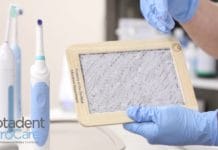Since periodontal disease is a chronic complex disease affecting 47% of the adult population in the United States,1 we know that treatment of the periodontium with an eye on oral-systemic links is an important focus. Proper nutrition should not be neglected as it plays an intricate role in the control of periodontal disease.
The good news is that a huge portion of the population is interested in preventing disease by using a nutrition-based approach. Many people want to avoid medications and decrease their risks of acquiring chronic diseases. The conversation about the benefits of nutrition when treating periodontal disease becomes a much easier task.
For dental professionals, understanding the mechanism of certain vitamins will help when explaining nutritional benefits. Having a short list of foods that the patient can acquire with such nutrients will also be helpful.
Vitamin D − The primary role of vitamin D is to maintain skeletal function and integrity. In addition, it plays a role in electrolyte reabsorption and immune system regulation.2
We get most of our vitamin D from the sun, and the secondary source is through dietary consumption. Vitamin D is synthesized in the skin when exposed to UV light. It is synthesized in the liver and kidneys with dietary consumption.
Some reports suggest that vitamin D deficiency is increasing. Contributing factors may include melanin in the skin, clothing, and increased use of sunscreen which all block UVB rays that produce vitamin D.2,3,4 Additional risk factors are malabsorption diseases, such as Crohn’s disease and celiac disease.2
Vitamin D has been shown to “affect the pathogenesis of periodontal disease via immunomodulation, increases bone mineral density, reduces bone resorption, and is important in fighting against agents that cause periodontal disease.”5 Good dietary sources for vitamin D are mushrooms, fatty fish, milk, cheese, egg yolks, and soy milk.
Never recommend a dietary supplement without the guidance of the patient’s physician. Vitamin D is a fat-soluble vitamin, which means there is a possibility of getting too much which would result in hypervitaminosis D.6 The symptoms of vitamin D toxicity, according to the Mayo Clinic, include “a buildup of calcium in your blood (hypercalcemia), which can cause nausea and vomiting, weakness, and frequent urination. Symptoms might progress to bone pain and kidney problems, such as the formation of calcium stones.”7
New studies in epigenetics have discovered several vitamin D receptor polymorphisms, one of which may play a role in periodontal disease.8 As the study of epigenetics progresses, clinicians may need to collaborate with medical doctors to choose the right treatment, home care, and nutritional counseling for these particular patients.
Vitamin C − When many people think of vitamin C deficiency, they think of scurvy. Symptoms of scurvy include swollen bleeding gums and loss of teeth.9 Vitamin C is also known as ascorbic acid; it is a water-soluble vitamin that is required for collagen synthesis. It also prevents damage from oxidative DNA because it is a ROS (reactive oxygen species) scavenger and plays a role in wound healing and certain immunological functions.10,11
Surprisingly, there are conflicting results from studies on the effects of vitamin C on periodontal disease. Some studies have not shown positive effects using vitamin C supplementation for treatment or prevention of periodontal disease. A review published in the Indian Journal of Applied Research states, “Although various infections and systemic diseases cause gingival bleeding, avitaminosis C does not cause commonly encountered periodontal disease, but it will aggravate the already established periodontitis. So, vitamin C should not be used for cure or prophylaxis of periodontitis in healthy well-nourished individuals.”12
However, other studies suggest vitamin C supplementation after periodontal therapy and to help implants osseointegrate after placement.10 Because vitamin C is a water-soluble vitamin, there is no risk of toxicity. What the body does not utilize will be excreted through urine-making supplements safe for recommendation.
Vitamin C deficiency is quite rare in developed countries. Good food sources of vitamin C include citrus fruit, kiwi, red and green peppers, broccoli, potatoes, cabbage, spinach, and strawberries.13
Vitamin B complex − Vitamin B complex is a combination of seven different B vitamins. Included in the combination are thiamine (B1), riboflavin (B2), niacin (B3), pantothenic acid (B5), pyridoxine (B6), biotin (B7 or B8), folic acid (B9), and cobalamin (B12). All B vitamins are water soluble; their primary function is cell metabolism, repair, and proliferation.
Oral manifestations of vitamin B deficiency include angular cheilitis and glossitis.10 Several studies have been done to assess a possible link between vitamin B deficiency and periodontal disease.
In one cohort study that followed 1,648 participants over a five-year period, it was determined that “vitamin B12 was inversely associated with changes in mean probing depth and mean CAL, and risk ratios of tooth loss over time.” The same study was unable to determine the mechanism by which vitamin B12 influenced probing depths and CAL. It was suggested that further studies be conducted to better understand the mechanism of the findings.14
Folic acid (B9) has also been shown to play a role in healing after periodontal treatment and flap surgery. Necrosis of the gingiva, periodontal ligament, and alveolar bone has been observed in animals with folic acid deficiency.15 Although the mechanism by which vitamin B complex assists in the healing process after periodontal surgery is not fully understood, the results from the studies indicate using a supplement or improving B vitamin intake through dietary sources is beneficial.
Dietary sources of B vitamins include peas, eggs, milk, fish, chicken, beef, broccoli, and leafy green vegetables.16
Vitamin K − Vitamin K is a fat-soluble vitamin, and it is a necessary component in blood clotting. It is also needed for proper bone metabolism. Compared to other fat-soluble vitamins, vitamin K is quickly metabolized, and very little vitamin K is found circulating in the blood.
Vitamin K is a cofactor in the proteins osteocalcin and periostin.18 Osteocalcin plays a major role in bone resorption and mineralization; periostin is vital in the hemostasis of periodontal ligaments.19,20 Recent studies hypothesize osteocalcin is more than just a protein used in bone metabolism, the correlation between osteocalcin and whole body metabolism has been identified.
In these studies, it was found that osteocalcin also appeared to regulate insulin. However, the specific function of osteocalcin has yet to be determined.21,22 In a comparative study, levels of periostin were measured in three groups of individuals − a healthy group, a gingivitis group, and a chronic periodontitis group. The study concluded, “The periostin levels in gingival crevicular fluid decreased proportionally with the progression and severity of periodontal disease, and negatively correlated with the clinical parameters.”23
Vitamin K is still being studied as a possible adjuvant or treatment in conjunction with other medications in patients with osteoporosis.24 Although vitamin K was first discovered in 1929, we are still learning about its mechanism of action.25 Dietary sources of Vitamin K include eggs, meat, broccoli, cabbage, and green leafy vegetables.26
In developed countries, vitamin deficiencies are rare, with 10.5% of the U.S. population deficient in vitamin B6, 8.1% deficient in vitamin D, 6% deficient in vitamin C, 2% deficient in B12, and less than 1% deficient in folic acid.17
There is evidence that vitamin deficiency increases with age, certain medications, and lifestyle choices such as smoking. Patients who are 60 or older or have a history of smoking may benefit more from vitamin supplements. Otherwise, healthy individuals should easily be able to achieve optimal nutrition through proper dietary foods. Nutritional counseling should be an adjuvant to all periodontal treatments, for optimal healing and continued maintenance.
References
- Centers for Disease Control and Prevention. Retrieved from https://www.cdc.gov/oralhealth/conditions/periodontal-disease.html
- Parva N.R., Tadepalli S., Singh P., Qian A., Joshi R., Kandala H., Nookala V.K., Cheriyath P. Prevalence of Vitamin D Deficiency and Associated Risk Factors in the US Population (2011-2012). Cureus. 2018 Jun; 10(6): e2741. Retrieved from https://www.ncbi.nlm.nih.gov/pmc/articles/PMC6075634/
- Bikle D.D. Vitamin Metabolism, Mechansm of Action, and Clinical Application. Chem Biol. 2014 Mar 20; 21(3): 319-329. Retrieved from https://www.ncbi.nlm.nih.gov/pmc/articles/PMC3968073/
- Shah D., Gupta P. Vitamin D Deficiency: Is The Pandemic for Real? Indian J Community Med, 2015 Oct-Dec; 40(4): 215-217. Retrieved from https://www.ncbi.nlm.nih.gov/pmc/articles/PMC4581139/
- Jagelaviciene E., Vaitkeviciene I., Silingaite D., Sinkunaite E., Daugelaite, G. The Relationship between Vitamin D and Periodontal Pathology. Medicina (Kaunas). 2018 Jul; 54(3): 45. Retrieved from https://www.ncbi.nlm.nih.gov/pmc/articles/PMC6122115/
- S. National Library of Medicine. Hypervitaminosis D. Retrieved from https://medlineplus.gov/ency/article/001594.htm
- The Mayo Clinic. Retrieved from https://www.mayoclinic.org/healthy-lifestyle/nutrition-and-healthy-eating/expert-answers/vitamin-d-toxicity/faq-20058108
- El Jilani M.M, Mohamed A.A., Zeglam H.B., Alhudiri I.M., Ramadan A.M., Saleh S.S., Elkair M., Amer I.B., Ashammakhi N., Enattah N.S. Association between Vitamin D receptor gene polymorphisms and Chronic Periodontitis among Libyans. Libyan J Med. 2015; 10: 10.3402/lijm. V10. 26771. Retrieved from https://www.ncbi.nlm.nih.gov/pmc/articles/PMC4368710/
- Scurvy. Retrieved from https://www.nhs.uk/conditions/scurvy/
- Najeeb S., Zafar M.S., Khurshid Z., Zohaib S., Almas, K. The Role of Nutrition in Periodontal Health: An Update. Nutrients. 2016 Sep; 8(9): 530. Retrieved from https://www.ncbi.nlm.nih.gov/pmc/articles/PMC5037517/
- Varela-Lopez A., Navarro-Hortal M.D., Giamieri F., Bullon P., Battino M., Quiles J.L. Nutraceuticals in Periodontal Health: A Systemic Review on the Role of Vitamins in Periodontal Health Maintenance. Molecules. 2018 May; 23(5): 1226. Retrieved from https://www.ncbi.nlm.nih.gov/pmc/articles/PMC6099579/
- Rathee M., Bhoria M., Kundu R. (2013). Vitamin C and Oral Health: A Review. Indian Journal of Applied Research. 3. 10.15373/2249555X/SEPT2013/139. Retrieved from https://www.researchgate.net/publication/294428327_Vitamin_C_and_Oral_Health_A_Review
- S. Department of Health and Human Services. National Institutes of Health Office of Dietary Supplements. Retrieved from https://ods.od.nih.gov/factsheets/VitaminC-HealthProfessional/
- Zong G., Holtfreter B., Scott A.E., Volzke H., Petersmann A., Dietrich T., Newson R.S., Kocher T. Serum Vitamin B12 in Inversely associated with periodontal Progression and Risk of Tooth Loss: A Prospective Cohort Study. J Clin Periodontol. 2016 Jan; 43(1): 2-9. Retrieved from https://www.ncbi.nlm.nih.gov/pubmed/26613385
- George J.P., Shobha R., Lazarus F.J. (2013). Folic acid: A positive influence on periodontal tissues during health and disease. International Journal of Health & Allied Sciences. 2. 10.4103/2278-344X.120582. Retrieved from https://www.researchgate.net/publication/307677876_Folic_acid_A_positive_influence_on_periodontal_tissues_during_health_and_disease
- National Health Service. B Vitamins and Folic Acid. Retrieved from https://www.nhs.uk/conditions/vitamins-and-minerals/vitamin-b/
- Centers for Disease Control and Prevention. CDC’s Second Nutrition Report: A comprehensive biochemical assessment of the nutrition status of the U.S. population. Retrieved from https://www.cdc.gov/nutritionreport/pdf/4page_%202nd%20nutrition%20report_508_032912.pdf
- S. Department of Health and Human Services. National Institute of Health. Vitamin K. Retrieved from https://ods.od.nih.gov/factsheets/VitaminK-HealthProfessional/
- Ram V.S., Parthiban, Sudhakar U., Mithradas N., Prabhakar R. Bonebiomarkers in Periodontal Disease: A Review Article. J Clin Diagn Res. 2015 Jan; 9(1): ZE07-ZE10. Retrieved from https://www.ncbi.nlm.nih.gov/pmc/articles/PMC4347190/
- Esfahrood Z.R., Vardian S.T., Yadegari Z., Adhim M., Saravi N.S.V. Periostin Levels in Saliva of Patients with Chronic Periodontitis. J Indian Soc Periodontol. 2018 Jan-Feb; 22(1): 25-27. Retrieved from https://www.ncbi.nlm.nih.gov/pmc/articles/PMC5855264/
- Zoch M.L., Clemens T.L., Riddle R.C. New Insight into the Biology of Osteocalcin. Bone. 2016 Jan; 82: 42-49. Retrieved from https://www.ncbi.nlm.nih.gov/pmc/articles/PMC4670816/
- Wei J., Karsenty G. An Overview of the Metabolic Function of Osteocalcin. Rev Endocr Metab Disord. 2015 Jun; 16(2): 93-98. Retrieved from https://www.ncbi.nlm.nih.gov/pmc/articles/PMC4499327/
- Balli U., Keles Z.P., Avci B., Guler S., Cetinkaya B.O., Keles G.C. Assessment of Periostin Levels in Serum and Gingival Crevicular Fluid of Patients with Periodontal Disease. J Periodontal Res. 2015 Dec; 50(6): 707-13. Retrieved from https://www.ncbi.nlm.nih.gov/pubmed/25529858/
- Iwamoto J. Vitamin K2 Therapy for Postmenopausal Osteoporosis. Nutrients. 2014 May; 6(5): 1971-1980. Retrieved from https://www.ncbi.nlm.nih.gov/pmc/articles/PMC4042573/
- Ferland G. The Discovery of Vitamin K and its Clinical Applications. Ann Nutr Metab. 2012; 61(3): 213-8. Retrieved from https://www.ncbi.nlm.nih.gov/pubmed/23183291
- U.S. National Library of Medicine. MedlinePlus. Vitamin K. Retrieved from https://medlineplus.gov/ency/article/002407.htm












